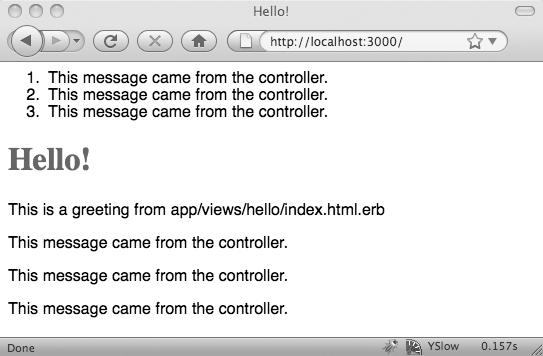Setting a Default Page
Before moving on to more âseriousâ concerns about developing applications, thereâs one question that web developers always seem to ask about 15 minutes into their first Rails experience:
How do I set a default page for the application?
The Rails welcome page, shown in Figures 1-3 and 1-10, is just plain ugly. There are two ways to change that:
Edit the public/index.html file and put in something more to your liking
Delete the public/index.html file and tweak the config/routes.rb file
The first one is pretty easy, but it doesnât integrate very tightly with your Rails application. The second approach lets you pick a controller that will run if the Rails application is run without specifying a controllerâthat is, in the test environment, by directly visiting http://localhost:3000/.
To make this work, youâll need to enter an extra line in the config/routes.rb file. Near the bottom of that, youâll see:
# You can have the root of your site routed with map.root -- # just remember to delete public/index.html. # map.root :controller => "welcome"
Change the last line of that to:
map.root :controller => "hello", :action => "index"
Save the file, make sure youâve deleted or renamed the public/index.html file, and restart your server. You should see something like Figure 3-6.

Figure 3-6. Accessing a controller by default, when the URL doesnât specify one
Donât ...
Get Learning Rails now with the O’Reilly learning platform.
O’Reilly members experience books, live events, courses curated by job role, and more from O’Reilly and nearly 200 top publishers.

